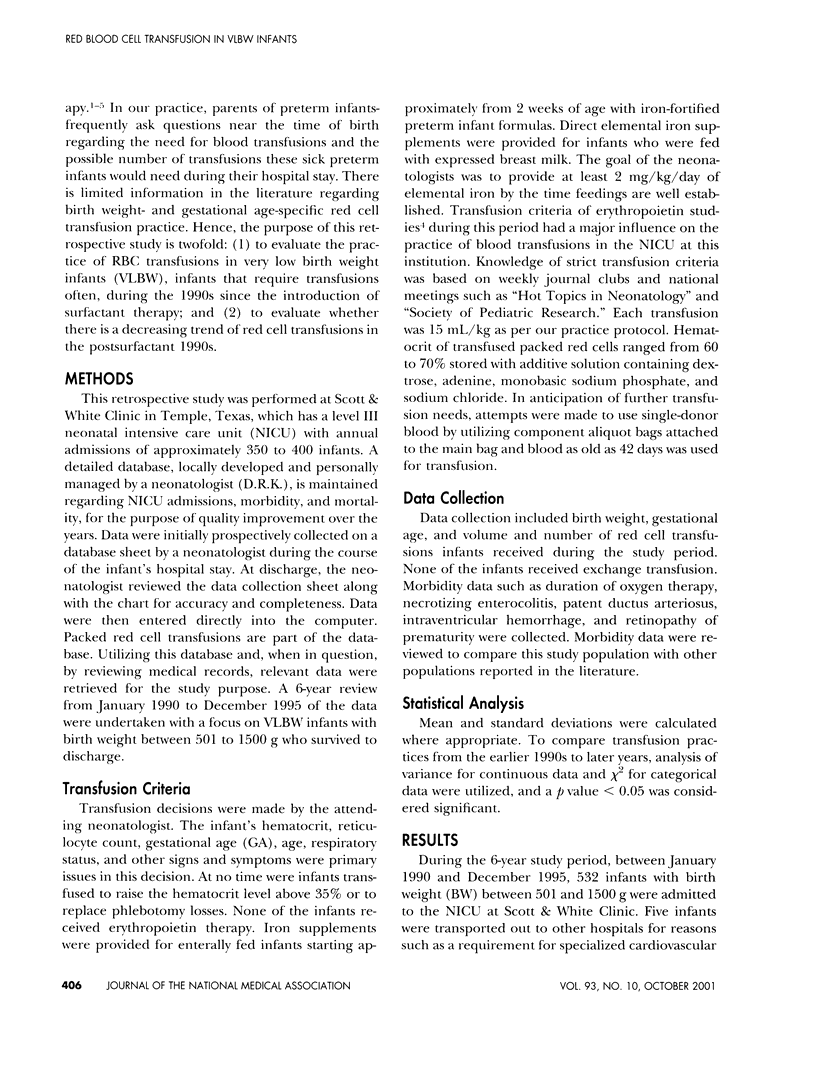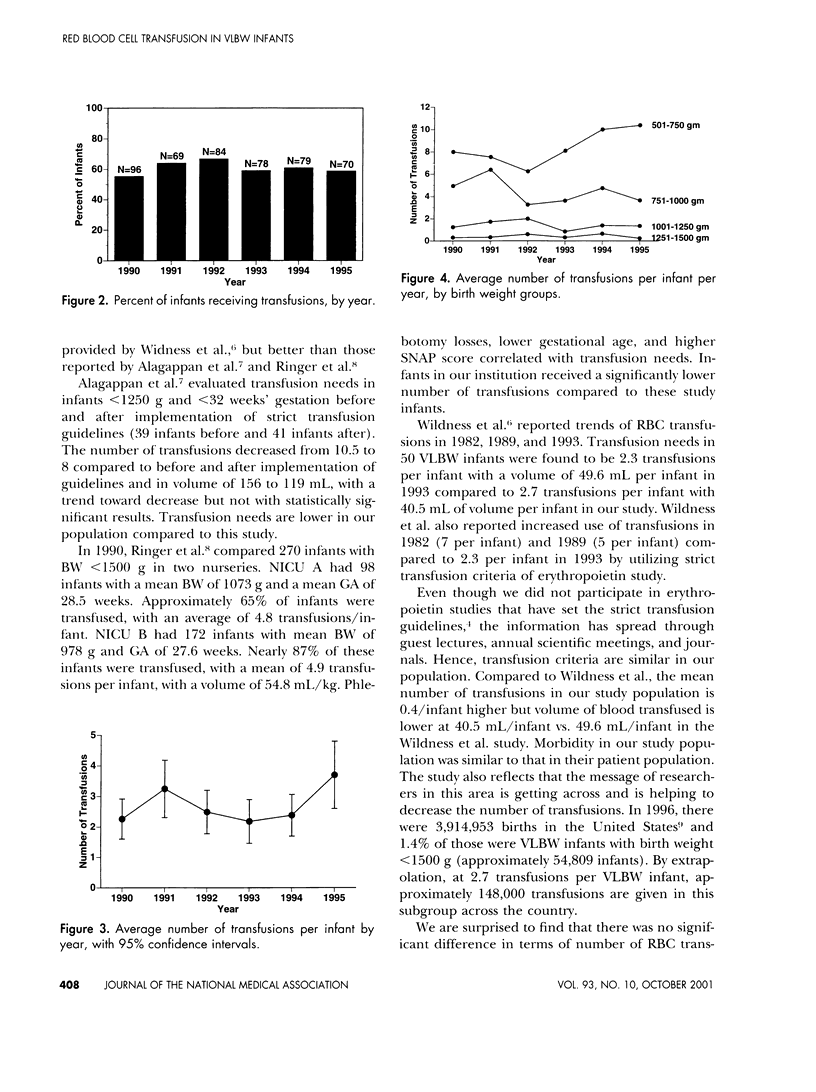Abstract
The purposes of this study are (1) to evaluate the practice of red blood cell transfusions in very low birth weight (VLBW) infants (between 501 to 1500 g) during the postsurfactant era of the 1990s; and (2) to evaluate if there is a decreasing trend in red cell transfusions in the 1990s. Database and medical records of VLBW infants admitted to the neonatal intensive care unit (NICU) between January 1990 and December 1995 at Scott & White Clinic, Temple, Texas, were reviewed. Five hundred twenty-seven infants were admitted to the NICU, excluding 5 infants that were transferred out for possible cardiac surgery or for other reasons. Fifty one (9.7%) of these infants died prior to discharge. Hence, data from 476 survivors were reviewed for red blood cell (RBC) transfusions. Transfusions were given at the discretion of the attending neonatologist. None of the infants received erythropoietin. Of the 476 infants, 289 (61%) received RBC transfusions during the hospital stay, with 2.7+/-3.6 transfusions per infant with a volume of 40.5+/-50.4 mL/kg. Smaller infants required significantly more transfusions compared to larger infants when divided into 250-g subgroups. No statistically significant difference was noted in the number of RBC transfusions per infant or number of infants transfused during the 6-year period from year to year. We conclude that VLBW infants in the 1990s postsurfactant era required 2.7 RBC transfusions per infant, on average, with the smallest infants requiring the most transfusions. These data will be helpful to counsel mothers in preterm labor regarding the need of transfusions for each birth weight category. Red cell transfusion practice has not changed over this 6-year period in the 1990s. Additional measures such as erythropoietin or even stricter transfusion criteria may be necessary to decrease transfusions further. However, safety of such measures should be carefully evaluated.
Full text
PDF




Selected References
These references are in PubMed. This may not be the complete list of references from this article.
- Alagappan A., Shattuck K. E., Malloy M. H. Impact of transfusion guidelines on neonatal transfusions. J Perinatol. 1998 Mar-Apr;18(2):92–97. [PubMed] [Google Scholar]
- Guyer B., Martin J. A., MacDorman M. F., Anderson R. N., Strobino D. M. Annual summary of vital statistics--1996. Pediatrics. 1997 Dec;100(6):905–918. doi: 10.1542/peds.100.6.905. [DOI] [PubMed] [Google Scholar]
- Lee D. A., Slagle T. A., Jackson T. M., Evans C. S. Reducing blood donor exposures in low birth weight infants by the use of older, unwashed packed red blood cells. J Pediatr. 1995 Feb;126(2):280–286. doi: 10.1016/s0022-3476(95)70561-9. [DOI] [PubMed] [Google Scholar]
- Liu E. A., Mannino F. L., Lane T. A. Prospective, randomized trial of the safety and efficacy of a limited donor exposure transfusion program for premature neonates. J Pediatr. 1994 Jul;125(1):92–96. doi: 10.1016/s0022-3476(94)70132-6. [DOI] [PubMed] [Google Scholar]
- Ringer S. A., Richardson D. K., Sacher R. A., Keszler M., Churchill W. H. Variations in transfusion practice in neonatal intensive care. Pediatrics. 1998 Feb;101(2):194–200. doi: 10.1542/peds.101.2.194. [DOI] [PubMed] [Google Scholar]
- Shannon K. M., Keith J. F., 3rd, Mentzer W. C., Ehrenkranz R. A., Brown M. S., Widness J. A., Gleason C. A., Bifano E. M., Millard D. D., Davis C. B. Recombinant human erythropoietin stimulates erythropoiesis and reduces erythrocyte transfusions in very low birth weight preterm infants. Pediatrics. 1995 Jan;95(1):1–8. [PubMed] [Google Scholar]
- Simon T. L., Alverson D. C., AuBuchon J., Cooper E. S., DeChristopher P. J., Glenn G. C., Gould S. A., Harrison C. R., Milam J. D., Moise K. J., Jr Practice parameter for the use of red blood cell transfusions: developed by the Red Blood Cell Administration Practice Guideline Development Task Force of the College of American Pathologists. Arch Pathol Lab Med. 1998 Feb;122(2):130–138. [PubMed] [Google Scholar]
- Strauss R. G. Red blood cell transfusion practices in the neonate. Clin Perinatol. 1995 Sep;22(3):641–655. [PubMed] [Google Scholar]
- Widness J. A., Seward V. J., Kromer I. J., Burmeister L. F., Bell E. F., Strauss R. G. Changing patterns of red blood cell transfusion in very low birth weight infants. J Pediatr. 1996 Nov;129(5):680–687. doi: 10.1016/s0022-3476(96)70150-6. [DOI] [PubMed] [Google Scholar]


